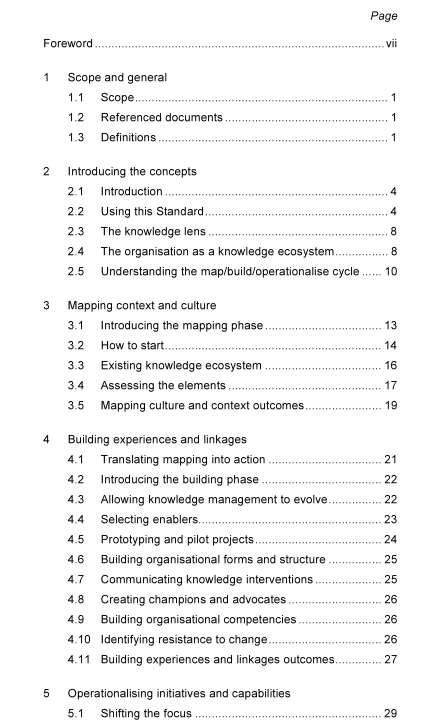AS 5037 pdf download – Knowledge management – a guide

AS 5037 pdf download – Knowledge management – a guide
2.1 Introduction Organisations are being challenged on how best to leverage their people and knowledge resources in an increasingly complex world. Examples of such challenges are: • An established organisation exposed to major structural change or reform and searching for new ways to adapt operationally and innovate.
• An existing organisation with well-networked members but hindered by low levels of knowledge sharing.
• A domestic organisation looking to operate internationally and faced with strong regional competition.
• A new organisation with highly knowledgeable staff that lack trust or cohesive networks between them.
• A mature organisation facing major demographic change and seeking to retain its corporate memory.
• An existing organisation with a well-developed culture of knowledge sharing and well-networked team members looking to raise their performance to the next level. Organisations that foster efficient knowledge networks and connections, explore processes and deploy people-centric technology have started to manage the complexity and ambiguity that permeates the knowledge ecosystem. This ecosystem is characterised by the pathways and connections between people, process, technology and content, which results in a rich web of relationships and interactions.
2.2 Using this Standard This Standard will walk you through the steps and implementation options for knowledge management to suit the unique requirements of your organisation’s context, capabilities and readiness. It describes a range of enablers (tools, techniques and activities) that can be used to implement knowledge management. Any organisation or individual can benefit from the approach outlined in this Standard.
Any or all of the following may influence an organisation’s receptivity to knowledge management:
• strategic intent, business aims and competitive positioning;
• culture;
• external environment;
• innovativeness;
• ability to adapt and respond to a constantly shifting business environment; and
• existing information infrastructure.
These factors, among others, will be discussed throughout the Standard. An understanding of these factors will assist you in tailoring knowledge initiatives to suit a particular context and environment. This Standard has adopted a knowledge ecosystem model. A knowledge ecosystem is characterised by dynamic relationships; connected networks; and internal process, content and technology. An ecosystem does not follow a traditional hierarchical model. An understanding of this model will provide your organisation with the sensitivity to realise that knowledge flows within these networks, pathways and relationships.
The key feature of this Standard is the suggested Map/Build/Operationalise cycle outlined in Sections 3 – 5. This cycle provides a generic, scaleable approach to incremental knowledge interventions.
Section 6 introduces you to enablers – tools, techniques and activities used in knowledge interventions to implement knowledge management. Measuring and evaluating the effectiveness of knowledge management remains an unsettled area. Section 7 will provide you with an overview of the different points of focus you can employ to ‘take the pulse’ of knowledge activities or interventions.
In Section 8, some of the theoretical underpinnings of knowledge management are discussed, along with an exploration of potential trends appearing on the horizon. Complexity theory is acknowledged as having an increasing influence on the organisational environment, along with cultural issues and smarter technology e.g. intelligent search engines, collaboration tools etc. This Section is not an exhaustive analysis of future trends nor is it intended to outline ‘set in stone’ predictions. Rather, it is intended to spark your thinking. Appendix A provides information about areas of practice related to knowledge management. Appendix B provides examples of job descriptions for knowledge management roles that can be customised to the requirements of your organisation.
International standards bodies, Governments, global organisations and professional associations have all explored the concept of knowledge management. The Committee referred to these various publications during the development of this Standard. A sample list of publications and pronouncements on knowledge management topics from both Australia and internationally is included in Appendix C. The outline in Figure 1 assists you in navigating this Standard.









